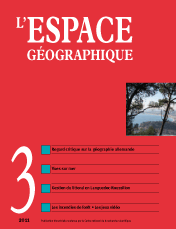

Revisiting German academic geography. Forty years of critical reappraisal (1969-2010)
In 1969 the German geographical conference in Kiel was the scene of profound, spectacular questioning of the discipline as it had been constructed in the German universities since the mid 19th century, in particular around the notion of Landschaft. This epistemological turning-point was also a key moment from which a critical history of “the golden century of German geography” (1871-1969) developed, focusing first on the construction of concepts and discourse, then on the positioning of specialists within a turbulent history (Third Reich, Cold War, colonial period), and recently on the reality of “a so-called German school of geography”, which ultimately appears as very diverse and fragmented.
keywords: CLASSIC PARADIGM, CRITICAL GEOGRAPHY, GERMANY, HISTORIOGRAPHY HISTORY OF GEOGRAPHY
(8 fig., 1 photo) (Appendix)
In many European coastal areas, urbanisation resulting from the rise of tourism industry and real estate activities is a critical issue in terms of land management and planning. Most of these developments can be seen as linked to the search for landscape amenities by people on holiday, those planning to buy second homes or those wishing to move to a new life. Coastal urbanisation therefore has a particular connection with the visual landscape properties of geographical locations. This article reports how, on the French Riviera, the issue of sea visibility has been studied in order to investigate how the contribution of a spatial knowledge of this amenity can serve town planning and land management.
keywords: COASTAL AREA MANAGEMENT, FRENCH RIVIERA, SEA VISIBILITY, TOWN PLANNING, VISIBILITY ANALYSIS
Analysis of the processes of conflicts: the case of the Languedoc-Roussillon coastal zone (1 fig.)
Since the late 1990s, conflict is an issue that is increasingly studied by geographers. Based on a survey of studies in geography of conflicts the present research is a complement to monographic and comparative approaches. This article aims to present the relevance of the study of antagonistic processes at meso scale, to propose a methodology and to present the results of an analysis of conflicts relating to use of the environment in the coastal zone of Languedoc-Roussillon, France: it will highlight the characteristics of conflicts (causes, manifestations, regulation) and the connections between conflicts and territoriality.
keywords: CONFLICTUALITY, ENVIRONMENT, LANGUEDOC-ROUSSILLON, TERRITORIALITY
Finding one’s way through video games: how to study the spatial representations and practices of video game players (1 fig., 1 tabl.)
While video games have become a major cultural practice, we still know little about the diversity of the video game audiences and their practices. Identifying the main issues in the reticularization of the territories in which video game are used, and rising above normative debates on violence and addiction, requires a multidisciplinary approach, at the interface between social and cultural geography, and the sociology of cultural practices. The analysis of video games as spatial systems enable an understanding of the interaction between the different levels of video game practices, and refocuses study on the players themselves.
keywords: CULTURAL PRACTICE, NETWORK, SPACE, TERRITORY, VIDEO GAME
André DAUPHINÉ. Mediterranean forest fires: a self-organized critical system modelled in geography (8 fig., 2 tabl.)
Forest fires are complex systems. After an empirical description, we focus on the three main fractal laws that characterize the space-time patterns of forest fires in the French Mediterranean region. The parabolic fractal model (FP) enables a measure of the fractal signatures. These show that forest fire behavior complies with the self-organized criticality theory.
keywords: COMPLEXITY, FOREST FIRE, FRACTAL, SELF-ORGANIZED CRITICALITY
Book reviews
In this issue of l’Espace géographique, you will find critical reviews of the following books
Gilbert M., Gilbert B. (dir.)(2009). La Distance, objet géographique. Rennes: Cercle de réflexion universitaire du lycée Chateaubriand, numéro spécial Atala, n° 12, 286 p. (François Durand-Dastès, université Paris Diderot-Paris 7)
Didelon C., Grasland C., Richard Y. (dir.)(2008). Atlas de l’Europe dans le monde. Paris: La Documentation française-Reclus, Cnrs Gdre S4, coll. «Dynamiques du territoire», 260 p. (Guy Baudelle, université de Rennes 2)
Miossec J.-M. (dir.)(2008). Géohistoire de la régionalisation en France. L’horizon régional. Paris: Presses universitaires de France, coll. «Quadridge. Manuels», 602 p. (Guy Baudelle, université de Rennes 2)
Heurgon É. (coord.)(2006). Le Développement durable. C’est enfin du bonheur! La Tour d’Aigues: Éditions de l’Aube, coll. «Société et territoire», 405 p. (Emmanuelle Hellier, université de Rennes 2)
Scarwell H.J., Roussel I. (dir.)(2010). Le Changement climatique. Quand le climat nous pousse à changer d’ère. Villeneuve-d’Ascq: Presses universitaires du Septentrion, coll. «Environnement et société», 358 p. (Yves Guermond, université de Rouen)
Brunel S., Pitte J.-R. (dir.)(2010). Le Ciel ne nous tombera pas sur la tête: 15 grands scientifiques nous rassurent sur notre avenir. Paris: Éditions J.-C. Lattès, 352 p. (David Blanchon, université de Paris Ouest Nanterre La Défense)
L’espace géographique 2/11![]()
![]() L’espace géographique 4/11
L’espace géographique 4/11
For subscribe or buy this issue: BELIN
![]() L’Espace géographique: contents
L’Espace géographique: contents
Last modified: April 10, 2013